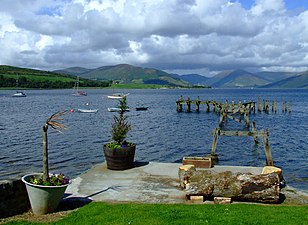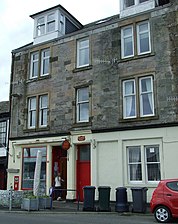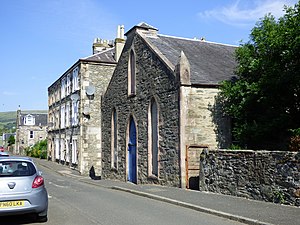Port Bannatyne
Geography
Port Bannatyne lies on the Firth of Clyde, approximately 2 miles (3 km) north of Rothesay on the Scottish Isle of Bute. Rhubodach is a further 6 miles (10 km) north away on the A886 and a Caledonian MacBrayne ferry service to the Cowal peninsula. This ferry runs every 30 minutes during the day. In Rothesay there is a Caledonian MacBrayne ferry service to Wemyss Bay in Inverclyde. This ferry leaves every hour (journey time 35 minutes) during the day.
Substantial slate and stone houses face the sea around Kames Bay. The village's focus was the stone pier mid-way along the south shore of Kames Bay. The bay provided mooring for yachts and fishing boats.
On the seafront are a shop/Post Office and the community-owned Anchor Tavern which was rescued from closure by local people who formed the Port Bannatyne Development Trust in 2020. The Port Royal Hotel was bought in 2000 by a Russo-Norwegian family who renovated the building and converted it into a replica of a Russian Tavern of Imperial Times, however it closed in 2017.
Above the village, with views across the sea to the Isle of Arran and the Argyll hills, is the Port Bannatyne golf-course. Built in 1912, the course now has 13 holes. The village has strong links overseas and has its own club for the French game of Pétanque, with a pitch, or piste, on the seafront.

In 2005, work was started on a new yacht marina at the west end of the village, beside an existing boatyard business. The small boatyard has grown into a stone-built breakwater which encloses part of Kames Bay and provides 108 berths for craft up to 16.5m in length.
History
The village started in 1801 with the building of a small harbour on Kames Bay. Lord Bannatyne of Kames Castle, at the head of the bay, planned the village in an attempt to rival Rothesay. Initially known as Kamesburgh, by the mid-19th century, steamers were calling there regularly. In 1860 the Marquess of Bute purchased this part of the island and renamed the village Port Bannatyne in honour of the long historical association of the Bannatyne family with the area. Boat building became an important local industry.
In 1879 a narrow gauge horse-drawn tram linked Port Bannatyne with Rothesay. This was electrified and extended across the island to Ettrick Bay in 1902.

In the Second World War midget submarines exercised in the bay and nearby Loch Striven. The luxury Kyles Hydro Hotel, overlooking the Port, was requisitioned by the Admiralty to serve as the HQ for midget submarine (x-craft) operations. In particular, it was from here (hotel renamed HMS Varbel) that the top secret and audacious attack on the Tirpitz was masterminded.
Gallery
-
The quay
-
The old pier
-
War Memorial
-
Post Office
-
Port Royal Hotel
-
Anchor Tavern (2011)
-
North Bute Primary School
-
Village Hall
-
Petanque Club
-
Sailing Club
References
- ^ "Mid-2020 Population Estimates for Settlements and Localities in Scotland". National Records of Scotland. 31 March 2022. Retrieved 31 March 2022.
- ^ "Rhubodach Port Information | Bute | CalMac Ferries". www.calmac.co.uk.
- ^ "Rothesay Port Information | Bute | CalMac Ferries". www.calmac.co.uk.
- ^ "Russian Tavern". The Port Royal Hotel. Retrieved 4 July 2012.
- ^ "Visitors". Port Bannatyne Golf Club. Retrieved 4 July 2012.
- ^ "Port Bannatyne Golf Club". Bute Sons & Daughters. Retrieved 4 July 2012.
- ^ "Port Bannatyne Petanque : Home". Retrieved 4 July 2012.
- ^ "Marina Services". Port Bannatyne Marina. Retrieved 12 February 2023.
- ^ "Port Bannatyne Tourist Information". About Britain. Retrieved 7 April 2007.
- ^ "Port Bannatyne". Undiscovered Scotland. Retrieved 7 April 2007.
- ^ "The Tirpitz Raid ("Operation Source")". Bute at War. Retrieved 31 December 2014.
External links
- Canmore - Bute, Port Bannatyne, General site record
- Canmore - Bute, Port Bannatyne, Shore Road, North Byte Parish Church site record
- Canmore - Bute, Port Bannatyne, 37 Marine Road, Port Royal Hotel site record
- Canmore - Bute, Port Bannatyne, Kyles of Bute Hydropathic site record
- Canmore - Bute, Port Bannatyne, Former Steamer Pier site record
- Canmore - Bute, Port Bannatyne, Marine Road Quay site record









